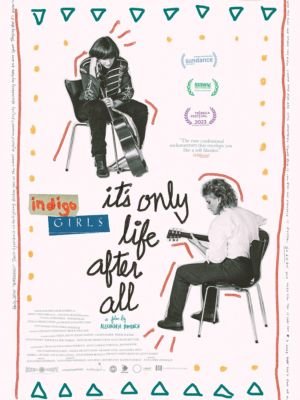
“It’s Only Life After All” is a comprehensive documentary about the Indigo Girls. With four decades in the books, there’s certainly much to cover. A phenomenon like the Indigo Girls deserves examination. But director Alexandria Bombach gets lost in the weeds — she uses so much of Amy Ray’s personal archive that she loses track of career trajectory, cultural context and impact.
She speaks with fans who often claim through tears that the Indigo Girls saved their lives. It’s easy to laugh at those statements, but they shouldn’t be dismissed. The songs hit people where they live; they say what can’t be said. If you’re already a fan (and I am), you know what their music means and has done for you. But if you don’t know, if you want to understand, “It’s Only Life After All” won’t help, even at two hours long.
Ray met Saliers in grade school; older Emily played guitar, and Amy loved her playing. They started making tapes together; singing together and harmonizing and writing songs together. The chemistry was immediate. There was a gap when they went to different colleges; both transferred to Emory University in Atlanta where they picked up where they left off.
They had no manager but they had drive — and an impassioned local fan base — in spades: Atlanta was their stomping ground in the mid-’80s. They were like nothing anybody’d ever seen before: close harmonies. Two acoustic guitars each person wrote half of every song poetic lyrics distinct sound rough guttural high clear wistful voices blend opposite essences
In 1989 came “Closer to Fine,” their breakout hit. I still remember where I was when I heard it for the first time (on the radio at the grocery store in Beacon Hill where I worked as a cashier). The harmonies stopped me dead in my tracks and the lyrics were so strange you had to pay attention. Michael Stipe brought them on tour with R.E.M. Mainstream success was disorienting, in a way: suddenly they had unusual stresses and tensions. Ray and Saliers are lesbians, and they had discussions about coming out publicly.
When they did finally come out, a reporter framed it as “This is the year you’ve come out.” Amy interrupted, “I’ve been out.” The homophobic atmosphere of the 1980s cannot be overstated; AIDS still decimated a generation then. But almost no public figures declared themselves. There were other artists dealing with similar things. Either directly before the Indigo Girls or directly after — none of whom get name-checked in “It’s Only Life After All.”
This documentary narrows things down quite a bit, even to the point of laziness. Ray and Saliers are interviewed exclusively. I know “talking head” is such an overused term but here “It’s Only Life After All” could’ve benefited from more — more voices, industry voices, cultural voices that could “place” the Indigo Girls in a wider context: what else was happening? What part of the folk tradition did they fit into (or not)? At one point Amy jokes, “Is there a category for Lesbian Christian Folk?” Many of her songs have clear Christian imagery; it’s a funny comment that passes without further exploration.
There’s a moment where she talks about the “folk scene” in the mid-’80s being mostly “quiet,” “intellectual,” serious,” whereas they were loud and raucous… so Bombach cuts to Judy Collins in what looks like the late-’60s sitting on a stool playing guitar with her hair down her back; this is supposed to be what the Indigo Girls didn’t want to be or something? Judy Collins’ heyday was 20 years before they came along! Neither Ray nor Saliers mention “Judy Collins” as an artist they didn’t want to emulate. Don’t dis a folk legend to make your point.
The Indigo Girls were not hugged critically. They were never profiled in Rolling Stone or Spin etc., and they were called “earnest” and/or “humorless.” Critics seem somehow not to have been listening. Here’s another verse from their first hit:
“Glitter & Doom,” among other things, is a jukebox musical by the Indigo Girls that shows how far their music has come. Their music will never go out of style. Shared career and “It’s Only Life After All” are important together but it doesn’t tell you why; it assumes you already do.
Also, Read On Fmovies
